Chapter 3, TURBO SYSTEM
Chapter 3, TURBO SYSTEMSystem Components
System ComponentsLOCATION AND OUTLINE OF TURBO SYSTEM COMPONENTS
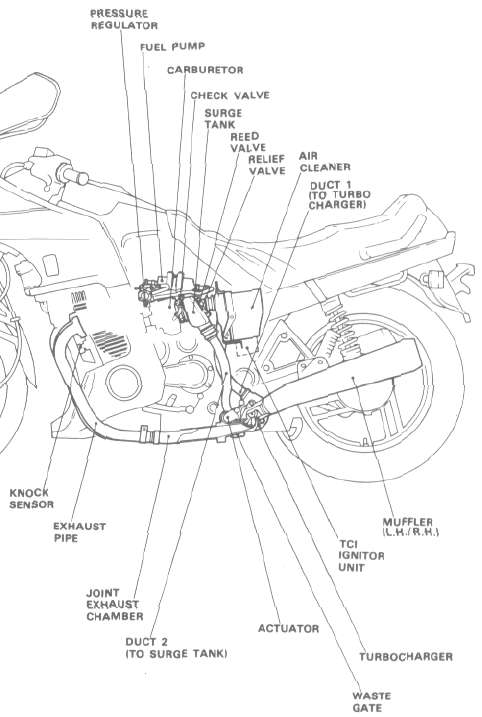
MAJOR COMPONENTS OF THE YAMAHA TURBO SYSTEM
|
EXHAUST SYSTEM |
(1) Exhaust pipe |
2) Joint exhaust |
(3) Turbocharger |
(4) Actuator |
(5) Wastegate |
(6) Muffler (L.H./R.H ) |
INTAKE SYSTEM |
(1) Air cleaner |
(21 Duct 1 (to turbocharger) |
(3) Duct 2 (to surge tank) |
(4) Surge tank |
(5) Reed valve |
(6) Relief valve |
(7) Drain valve |
FUEL SYSTEM |
(1) Electric fuel pump |
(2) Pressure regulator |
(3) Check valve |
(4) Carburetor |
LUBRICATION SYSTEM |
(1) Scavenge pump |
(2) Delivery hose (to turbocharger) |
(3) Scavenge hose (to scavenge pump) |
(4) Check valve |
(5) Oil filter |
IGNITION SYSTEM |
(1) TCI ignitor unit |
(2) Boost sensor |
(3) Knock sensor |
CONSTRUCTION OF THE TURBOCHARGER UNIT
The turbocharger unit is made up of the following components: the compressor, which produces the boost pressure by compressing air; the turbine, which converts the exhaust gas into energy to drive the compressor; the bearings, which support the rotor shaft as it rotates at high speed; and the boost pressure control unit, which is composed of the wastegate and its actuator valve.
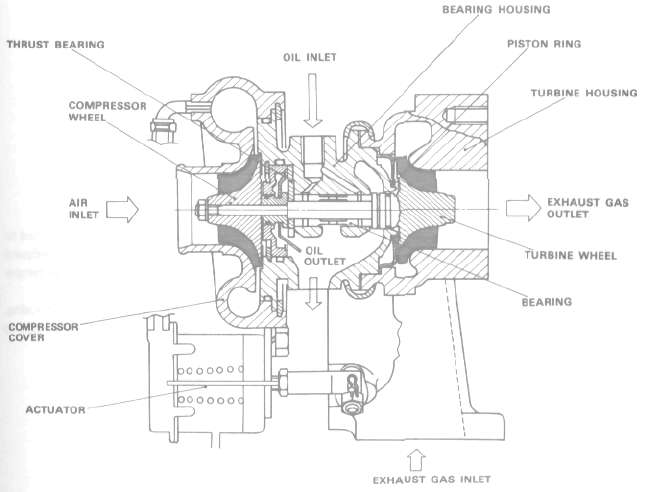
Compressor
The compressor is a rotor located within a housing of decreasing volume. As the compressor rotor turns, in excess of 100,000 rpm, it moves air by centrifugal force. Because of the design, the air being sent to the carburetors slows from its initial velocity, but because of the decreasing volume of the housing, the air pressure increase.

Turbine
The turbine is driven by the engine's exhaust gases. The rotating turbine, which is connected to the compressor, turns the compressor. The turbine rotor is constructed of a ultra heat-resistant alloy, which is a precision casting that can withstand high-speed operation at extreme temperatures. The turbine housing is shaped like a snail and is called a scroll casing. This design directs the exhaust gases into the turbine rotor blades. Because the turbine housing, like the turbine rotor, is subjected to high temperatures, resisting distortion and oxidation due to extremely high temperatures.
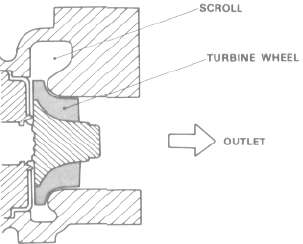
Floating bearing
Floating bearings support the turbine shaft as it turns at speeds of 100,000 to 210,000 rpm. It is the fact that these bearings "float" in a constant flow of lubricating oil that permits the turbine/compressor shaft to spin at such high rpms. These bearings are designed to turn freely between the shaft and the bearing housing. Lubricating oil surrounds the bearings, flowing freely yet absorbing the vibrations created by the turbine/compressor shaft. To ensure that the oil is not stressed any more than necessary, the bearing housing has special seals that separate the exhaust gas driving the turbine from the lubricating oil.
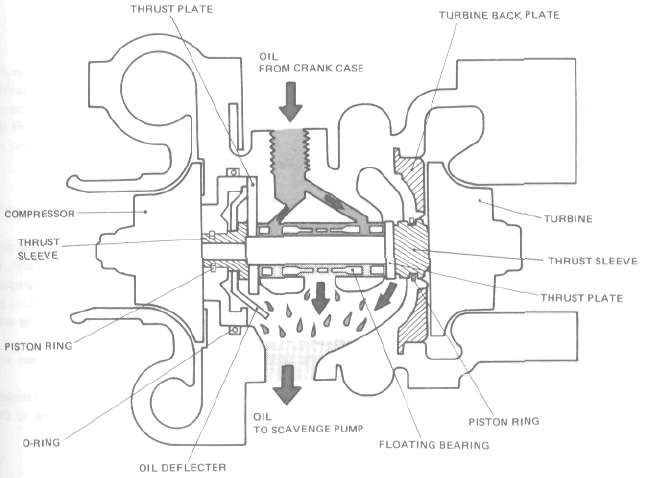
Cooling of the bearing section
During full-throttle, high speed operation the temperature of the inlet at the turbine is more than 850°C. and even the surface temperature of the turbine housing is as high as 550 to 750°C. If such heat is transferred to the center bearing housing, the bearing temperature will rise accordingly. This reduces the oil's viscosity, making it ineffective in absorbing the vibrations from the floating bearing. To guard against these high temperatures, the rear of the turbine is covered with a backing plate so that an air chamber is formed between the backing plate and the housing, thus serving as a heat insulator.
Gas seal on the turbine side
The shaft on the turbine side is provided with a ring groove into which a small-diameter ring is fitted to seal out the exhaust gas from the turbine. The ring is forced against the center bearing housing by its own tension so that it does not turn with the shaft; the shaft rotates while keeping full contact with the ring.
Oil seal on the compressor side
A ring is fitted in the groove around the thrust collar to provide a good seal.
Boost pressure control
When the engine speed is low, that is, when the exhaust gas flow is not much, the boost pressure is also low. But when the engine speed increases, the turbine wheel spins faster, thus increasing the boost pressure. As engine rpms increase, so does boost pressure, further increasing power. If the boost pressure is not controlled, it will increase to the point where the engine will be damaged. To control boost pressure, a valve is used through which exhaust gas is routed to bypass the turbine. Boost pressure is thus controlled.
Wastegate valve
The wastegate is opened and closed by the actuator valve which is operated by the boost pressure. The wastegate limits the boost pressure supplied to the engine.
The boost pressure is carried from the compressor, through the rubber hose, to the actuator chamber. When the boost pressure exerted on the chamber goes beyond the preset level, it overcomes the spring force and pushes the diaphragm and linkage. This opens the wastegate valve to permit the exhaust gas to flow to the right-hand muffler. As a result, the amount of exhaust gas exerted on the turbine wheel is reduced, and thus the speed of both turbine and compressor wheels is slowed down. The result is a decrease in the boost. When the boost pressure is below 53.2 kPa (400mmHg, 15.7 inHg), all exhaust gases are channeled through the turbine vanes.
When the boost reaches 53.2 kPa (400 mmHg, 15.7 inHg), the diaphragm of the wastegate actuator causes the gate to open, and the excess exhaust gas flows through the bypass to the exhaust pipe.
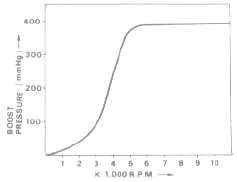
Wastegate valve:
Stroke: 5 mm
Pressure: 83.4 ± 6.9 kPa (0.85 ± 0.07 kg/cm2) (12.1 ± 1.0 psi.)
Turbo Troubleshooting
Turbo TroubleshootingINTRODUCTION
The Yamaha turbo system is made up of three basic systems: the fuel system, the intake system and the exhaust system. These systems work together to Increase the performance and efficiency of the engine.
The fuel system must provide fuel to the carburetors under normal operation as well as during boost operation. Due to the precision nature of many components in the turbo system, it is imperative that the fuel tank, fuel filters and carburetors be completely free of rust, fuel residue and other contaminants.
The intake system allows the engine to draw clean air through the air cleaner at low speeds, and forces pressurized air from the turbocharger compressor to the engine. This system must be free of pressure leaks to perform its function properly.
The exhaust system drives the turbocharger turbine. The exhaust joints should be tight to prevent exhaust pressure leakage, and the turbocharger must function properly.
Since these three systems are interdependent a problem with any one or more components in any of the three systems can cause a performance problem with the entire turbo system.
VERIFY THE PROBLEM
Diagnosing performance problems requires that you first determine the cause of the problem by verifying the symptoms. Usually, performance problems fall into three categories: the motorcycle acts like It Is running out of fuel, it overflows fuel (runs rich), or it runs poorly while on boost. By using customer information, a comprehensive test ride and a logical troubleshooting procedure, you should be able to locate and correct the problem quickly and easily.
Normally, fuel overflow is due to a check valve which is stuck open or a pressure regulator which Is stuck closed. Fuel overflow can also be caused by a clogged petcock filter. Also be certain that the carburetors are properly cleaned, that the needle valves seal properly, and that the float levels are properly set.
NOTE: The proper float level specification should be 21.5 + 5mm.
Fuel system problems may also be causing high performance problems. If there is a high performance problem, look for conditions such as a plugged fuel tank cap vent or Improper carburetor adjustments in addition to the fuel system troubleshooting procedures described below.
FUEL SYSTEM TROUBLESHOOTING

If you have determined that the motorcycle acts as If It Is running out of fuel, running rich, or It runs poorly while on boost, perform the following tests.
NOTE: All of the above turbo conditions are usually caused by fuel system contamination.
This procedure requires extensive handling of gasoline. Gasoline Is extremely flammable. To avoid severe injury, do not allow open flames, sparks, cigarettes, or any other sources of Ignition near the area In which you are working.
FUEL FILTER TESTS
1. Remove the tank cover and side panels.
2. Turn the petcock valve to the "OFF" position.
3. Remove the output hose from the petcock.
4. Connect a 5/16-inch ID hose approximately two feet long to the outlet side of the petcock.
5. Place the other end of the hose in a clean drain pan.
6. Turn the petcock to the "ON" position; a normal gravity flow of fuel should be seen.
7. Turn the petcock valve to the reserve position.
Again, a normal gravity flow of fuel should be seen.
NOTE: Observe the fuel (towing Into the pan. It contaminants are present In the fuel flowing into the drain pan with the petcock In the reserve position, the entire fuel system Is most likely contaminated and will need to be clean.
8. If fuel did not flow correctly in either of the above tests, repeat the test procedure with the fuel cap removed. If the fuel flow improves, clean or replace the fuel cap If the flow did not improve the petcock, petcock litters, and the fuel tank will need to be cleaned thoroughly. Refer to Bulletin M84-016.
9. Remove the conical filter located in the inlet side of the fuel pump. Clean if necessary. If contaminants are present in this filter a lean condition could occur, especially under boost conditions.
10. Reconnect the proper fuel lines to the petcock and fuel pump.
FUEL PUMP PRESSURE TEST
If the problem that was originally verified still exists after performing the fuel filter tests, the fuel pump pressure will need to be tested.
1. Disconnect the output hose from the fuel pump assembly.
2. Connect a 5/16-inch ID hose, approximately two feet long, to the fuel pump fitting.
3. Place a graduated container, such as a Ratio Rite™ cup, underneath the hose coming from the fuel pump.
4. Turn the ignition on, place the transmission in gear and push the starter button. The engine should not turn over, but the fuel pump should operate and pump fuel.
5. The fuel pump should pump a minimum of 300cc of fuel in 15 seconds. If it does not pump enough fuel in the test the fuel pump should be replaced.
CHECK VALVE AND PRESSURE REGULATOR TEST
Again, if the problem has not been located with the above tests, proceed to test the check valve and pressure regulator.
1. Remove the fuel tank and fuel pump
2. Disconnect the lower hose from the check valve and connect a two-foot length of 5/164nch ID fuel line to the lower fitting of the check valve.
3. Connect another two-foot length of fuel line to the pressure regulator outlet fining. Run both of these fuel lines into a drain pan.
4. Reinstall the fuel pump and fuel tank and connect the fuel outlet hose to the "OUT" fitting of the petcock.
5. Plug the "IN" fitting of the petcock to prevent fuel leakage. Recheck all lines to make sure they are properly connected to avoid fuel leakage.
6. Turn the petcock to the "ON" position. No fuel should flow when the engine is not running.
7. Turn the petcock to the "RESERVE" position. Again, no fuel should flow when the engine is not running. If fuel flows out of the check valve, then the check valve is defective and should be replaced. The same is true if the fuel leaks from the pressure regulator: If It leaks, replace It.
8. Turn the Ignition on. place the transmission in gear and push the starter button. The fuel pump should operate and pump fuel but the engine should not turn over.
9. Fuel should be pumped out of the check valve outlet hose, but not from the pressure regulator. If the pressure regulator does allow fuel to flow, then It should be replaced.
10. Place a graduated container, such as a Ratio Rite™ cup, under the check valve outlet hose. Push the starter button as before and pump fuel into the container for exactly 15 seconds. The amount of fuel pumped should be at least 300ca If It is less, replace the check valve.
11. Perform this same test with the check valve outlet hose plugged closed. The output through the pressure regulator outlet hose should also be at least 300cc for 15 seconds of pumping. If it Is less, replace the pressure regulator.
INTAKE SYSTEM TROUBLESHOOTING

Intake system problems, such as low or no boost pressure, can be caused by a leak in the pressurized system. Usually, a problem here is found by a quick visual inspection of the system's components.
1. Inspect all of the exhaust system joints for leaks and tighten the clamps as necessary. It is usually helpful to remove the exhaust clamp bolts and coat the threads with anti-seize compound. This allows better tightening and helps prevent thread seizure or stripping. Also replace any gaskets that are damaged or worn.
2. Inspect the intake air ducts between the air box and the compressor, and from the compressor to the surge tank. The connections of these ducts must be tight to prevent air pressure leaks, and to prevent foreign material from entering the compressor or the engine
3. Poor boost pressure many times Is caused by a wastegate that is partially stuck open, usually as a result of carbon deposits. These deposits will need to be scraped clean to allow normal closing. To test for this condition, rev the engine to 4.000 rpm and check for exhaust gas exiting the right muffler. If there Is, then the wastegate is stuck open.
4. The wastegate may also be held open by a rusty wastegate actuator pivot bearing. The best method of checking wastegate actuator movement is to locate the 10mm hex nut on the top of the turbocharger and turn the nut with a wrench. Only a small space is available to work In, but sufficient movement can be made to move the actuator In and out.
NOTE: While moving the actuator, spray Yamaha "GP Lube" on the shaft and bushings for lubrication. Some actuators may actually be frozen In place It this is a problem, spray the "GP Lube" liberally on the bushing and work the actuator in and out until It works freely. Turbocharger removal should not be necessary unless the actuator is badly rusted. It is recommended that this procedure be performed during normal tune-up maintenance to prevent sticking problems at a later date.
5. It poor boost pressure is still a problem after the above steps have been followed, the surge tank should be inspected for leakage at the reed valves, relief valve and drain valve Test the drain valve for leakage by holding the end of the drain hose in a cup of water. While on boost, no air leakage should be noticed (bubbles in the water). The reed valves and relief valve must be checked visually for proper closing.
6. Poor boost pressure can also be caused by glazed spark plugs, inoperative boost or knock sensors, or fuel delivery problems.
NOTE: Spark plugs should be replaced whenever performance problems are encountered. Due to the high performance of the turbo engine, spark plug glazing is a greater possibility than with other engines.
If these procedures do not solve the poor boost pressure problem, contact your Regional Technical Advisor.
EXHAUST AND TURBO LUBRICATION TROUBLESHOOTING

Exhaust (or turbocharger) and lubrication problems usually fall Into two categories: oil leakage from the exhaust and lack of lubrication at the turbocharger.
OIL LEAKAGE FROM EXHAUST
Oil leakage from the exhaust, whether on a new machine or one that has been In use, is usually due to the old check valve being stuck in the open position. This allows oil to run into the turbocharger and then into the exhaust pipes. This can occur because the seal in the turbocharger is similar to a piston ring; It only seals when the turbocharger is running. Oil can drain from the turbo Into the pipes or be pushed Into the surge tank when the turbo operates. Inspect the check valve by removing and disassembling it. Thoroughly clean the valve, and inspect the spring/ball for proper closing.
Other causes of oil In the exhaust or surge tank can be due to a blocked oil scavenge (return) line or a poor O-ring seal between the feed and scavenge rotors in the oil pump assembly. A defective oil ring seal in the turbocharger Is possible but always verify that the check valve and oil lines are functioning properly before replacing the turbocharger. Finally, any oil In the exhaust pipes, joint, or mufflers must be cleaned out before running the engine Otherwise excessive smoking and carbon build-up will occur r within the exhaust system.
LUBRICATION FAILURES
If the turbocharger makes noise when the engine is running, you will need to check for physical damage due to foreign objects, for lack of lubrication, or for turbocharger bearing failure. Before removing the turbocharger, remove the left hand muffler and inspect the turbine Some "up and down" and "Side to side" play Is normal. Excessive movement is not. Consult your Regional Technical Advisor it the free play of the turbine compressor shaft Is questionable. To test for turbo bearing operation, start the engine and watch the turbine rotation at idle speed.
Do not look directly Into the turbine outlet as carbon or other exhaust particles could come out at high velocity and cause Injury.
If the turbine rotates freely at idle, then quickly increases rotation when the engine is revved, the turbocharger bearings are in good condition.
Defective bearings will cause the turbine to rotate slowly or erratically. If bearing failure has occurred. you must determine the cause for the failure. Inspect the oil delivery line for kinks or restrictions, type, conditions, and amount of motor oil. Also. question the customer on oil change intervals and the necessity of a proper "warm up" and "cool down" period.
Because the turbocharger runs at very high rpm - nearly 100.000 rpm at engine Idle speed — proper warm-up time is recommended to prevent bearing damage. Also, since the turbocharger runs at very high temperatures, the motor oil must be changed more frequently. Refer to the service manual for specified service Intervals. Another important caution Is to allow the turbocharger to "cool down" for a minute or two before turning off the engine A hot turbocharger can actually cook the small amount of oil on its bearing surfaces. This breakdown of the oil leaves coke deposits In the small oil galleries feeding the bearings which can eventually clog the galleries and lead to lubrication failure.
Disassembly (Exhaust Components)
Disassembly (Exhaust Components)EXHAUST SYSTEM
The exhaust system is composed of exhaust pipes, an exhaust chamber/turbocharger assembly, and mufflers. The turbocharger is operated by the engine's expelled gases and this in turn operates the compressor rotor, which creates the boost pressure for the combustion chambers. The boost pressure is controlled by a wastegate that channels unneeded exhaust out the right hand muffler. See the block diagram below.

The turbocharging system features a patented Yamaha exhaust joint chamber. The exhaust pipes are grouped together to supply an even exhaust flow - a 360'^interval with less interference from exhaust pulses. As a result, the engine gives a smooth, ever-increasing curve of performance.

EXHAUST SYSTEM REMOVAL
CAUTION:
Do not, under any circumstances, disassemble the turbocharger unit itself. If the turbo-charger unit fails, it must be replaced.

NOTE: Removing the left muffler, turbine rotation can be inspected without removing the turbo-charger.
A-VIEW

DISASSEMBLY
Exhaust Pipe and Exhaust Chamber
1. Remove the lower, fairing panel that shields the turbocharger/exhaust chamber assembly.
NOTE: The lower fairing panel need not be removed; however disassembling the exhaust pipes and exhaust chamber will be easier,


2. Remove the exhaust pipe mounting flange nuts.

3. Loosen the clamps that mount the exhaust chamber to the exhaust pipes.

4. Remove the exhaust pipes.
5. Remove the nuts at the exhaust chamber /turbocharger mounting flange, and remove the exhaust chamber.

Mufflers
1. Remove the left muffler mounting bracket bolts.

2. While supporting the left muffler, loosen the coupling bolt and nuts at the turbocharger, and remove the left muffler.

3. Remove the right muffler mounting flange bolt.

4. While supporting the muffler, remove the mounting flange bolts that connect the muffler to the turbocharger, and remove the muffler.

Turbocharger
1. Loosen the clamp screws.

1. Duct to surge tank

1. Duct from air cleaner
2. Remove the scavenging oil hose.

NOTE: Using a suitable clamp or bolt, close off the oil hose so that oil will not leak out.
3. Remove the banjo fitting bolt from the oil supply hose.

4. While supporting the turbocharger, remove the mounting nuts, and remove the turbocharger.

CAUTION: Don't allow foreign particles to enter the turbocharger, when removing the turbo-charger.
Inspection (Exhaust Components)
Inspection (Exhaust Components)INSPECTION
Turbocharger
1. Ensure that the turbine and compressor rotors turn smoothly.

2. Ensure that the actuator valve and waste-gate assembly operate correctly.
3. As the turbine is turned it should not bind at any point, there should be no side play, and there should be no axial play in the turbine/compressor shaft.
WARNING: IF THE TURBOCHARGER UNIT DOES NOT OPERATE PROPERLY, THE ENTIRE UNIT, INCLUDING THE ACTUATOR VALVE/WASTEGATE ASSEMBLY, MUST BE REPLACED.
Exhaust Pipes and Mufflers
CAUTION: Check the exhaust pipes, exhaust chamber, and left and right mufflers for any leaks or material that could make its way into the turbocharger unit. Also check the oil scavenge and oil supply lines for any leaks. Replace as necessary.
Actuator Valve/Wastegate Assembly Using the following procedure, check the pressure on the actuator valve.
1. Install the turbocharger pressure gauge (P/N YM-33076) and the dial gauge as shown below.

1. Turbocharger pressure gauge

1. Turbocharger 2. Dial gauge 3. Bellows pressure gauge 4. Relief valve 5 Actuator

|
Dial gauge read |
Pressure gauge read |
1.0 mm (0.04 in) 5.0 mm (0.20 in) |
67.7 ± 2.9 kPa 83.4 ± 6.9 kPa |
0.69 ± 0.03 kg/cm2 0.85 ± 0.07 kg/cm2 |
9.81 ± 0.43 psi 12.1 ± 1.00 psi |
CAUTION: Do not loosen the actuator shaft locknut. The shaft and locknut held fast by an adhesive. An attempt to force them apart will cause damage to the actuator diaphragm.

Reassembly (Exhaust Components)
Reassembly (Exhaust Components)REASSEMBLY
CAUTION:
The exhaust system operates under very high pressure from the turbocharger. Every connection and joint in the system must be tight, and new gaskets must be used. There must be no exhaust leaks or a drop in performance will result.

EXHAUST SYSTEM REASSEMBLY
CAUTION: Observe the following assembly instructions carefully. The exhaust system must be assembled in the order listed below.
1. Mount the sub-muffler and the protector to the turbocharger.

1. Protector 2. Sub-muffler
Tightening torque: 12 Nm (1.2m-kg, 8.7 ft-lb)
2. Mount the turbocharger to the frame, and finger-tighten the mounting nut.

3. Connect the ducts 1 and 2 to the turbocharger, and tighten the clamp screws.

1. Duct from air cleaner

1. Duct to surge tank
Tightening torque: 2Nm (0.2 m-kg, 1.4 ft-lb)
4. Connect the oil lines, and tighten the banjo fitting bolt.


Tightening torque. 21 Nm{2.1 m-kg, 15 ft-lb)
5. Install the exhaust chamber to the turbocharger, and finger-tighten the mounting bolt to the frame.
6. Tighten the flange nuts (2).

Tightening torque: 20 Nm (2.0 m-kg, 14 ft-lb)
7. Install the exhaust pipes to the exhaust chamber, and install the ringnuts to the cylinder head.
8. Tighten the ringnut securing nuts (8).

Tightening torque: 10 Nm (1.0 mkg, 7.2 ft-lb)
9. Tighten the clamp bolts (4)

Tightening torque. 20 Nm (2.0 m-kg, 14 ft-lb)
10. Tighten the exhaust chamber mounting bolt.
Tightening torque: 25 Nm (2.5 m-kg, 18 ft-lb)
11. Tighten the turbocharger mounting nuts (2).
Tightening torque: 20 Nm (2.0m.kg, 14 ft-lb)
12. Install the left muffler to the turbo-charger, and finger-tighten the bolt and nuts (2).

13. Install the left footrest bracket.
14. Tighten the coupling bolt and nuts (2).
Tightening torque: 20 Nm (2.0 mkg, 14 ft-lb)
15. Tighten the footrest bracket securing bolts (3).

Tightening torque: 25 Nm (2.5 m-kg, 18 ft-lb)
16. Install the right muffler to the sub-muffler.
17. Install the right footrest bracket.
18. Tighten the clamp bolt.

Tightening torque: 20 Nm (2.0 mkg, 14ftlb)
19. Tighten the footrest bracket securing bolts.

|
Tightening torque: |
|||
|
|
Nm |
m-kg |
1Mb |
|
M8 |
20 |
2.0 |
14 |
|
M10 |
25 |
2.5 |
18 |
Intake Components
Intake ComponentsINTAKE SYSTEM
The intake system consists of an air cleaner, a surge tank, a reed valve, and a relief valve. All work together to provide the correct amount of air over the entire range of the engine's performance requirements, from low to high speeds.

SIDE VIEW

SECTIONAL SIDE VIEW

Surge Tank
The surge tank is an alloy air chamber that can hold large amounts of compressed air under constant pressure. The relief valve and the reed valve are located in the surge tank.

Relief valve
The relief valve releases excessive boost pressure in the surge tank if boost pressure becomes to high. This is a back up system to the waste gate. If the wastegate actuator valve should fail, the relief valve will open the surge tank, reducing the excess boost pressure and thus protect the engine.
Relief valve setting pressure: 98.1 kPa (1.0 kg/cm2, 14.2 psi)
Reed valve
The reed valve opens at low engine RPM when the turbocharger does not provide sufficient boost pressure. In this way, turbo lag is largely eliminated and better throttle response can be obtained.


SECTION BB RELIEF VALVE

SECTION A A REED VALVE
NOTE: The relief valve assembly must be installed into the surge tank with the arrow pointing upward; see the illustration.
Drain valve:
This valve is provided to drain the surge tank of trapped fuel. It remains open when the engine is at a stop but starts to close as the surge tank is charged.
Drain valve closing pressure: 4.9 kPa (0.05 kg/cm2, 0.7 psi)

DRAIN VALVE
Turbo Lubrication System
Turbo Lubrication SystemLUBRICATION SYSTEM
The turbo unit is pressure-lubricated from the main engine oil gallery. A check valve is installed on the outlet o' the engine main oil gallery to stop oil flow to the turbo unit when the engine is not running. A scavenging pump rotor is equipped behind the original oil pump rotor to retrieve the oil from the turbo unit, ensuring a constant flow of oil.
Check valve opening pressure: 24.5 kPa (0.25 kg/cm , 3.56 psi)
RIGHT SIDE VIEW
NOTE:
This filter traps material missed by the engine filter. It is made of a coarser mesh than the engine filter and must be cleaned after the first engine oil filter inspection (500 km) and thereafter every
LEFT SIDE VIEW
OIL PIPE FOR TURBO UNIT
OIL PUMP








